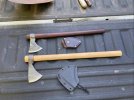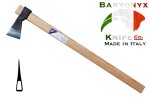Hardball,
I don't know much about political correctness(or much else for that matter

,
but over the years,in learning about axes,this is kind of a picture i put together for myself:
"Tomahawk" was never really a specific tool,or even a type or a pattern of an axe.
To the Native people initially it was a curio,not anything they had any use for really,but a cool,obviously valuable in some way thing,full of potential.
The use of "t" as a weapon is very impractical and awkward,however in part a job of a weapon is to intimidate,so they were probably used to sow fear in the enemy,and (confidence in the wielder

To the white colonials it definitely represented Value,and the Native population kinda went with the idea...Later in the 18th and early 19th c.c. tomahawks,sometimes elaborately engraved and decorated(at times ordered to be custom-made,from as far away as Sheffield),were given as kinda very special gifts to important people on important occasions,sometimes those of State.
So it was a status-object,that is to say Bling.It's enough to take a look at some of Curtis photographs to see what the people in the photos think of these thing,the way they display them.
Later,of course many of those came into their own as wood-working and agricultural tools.Native craftsmen i'm sure quickly found many useful things to do with these,because that's after all what many(some?)of "tomahawks" were.
The first traders carried random goods,they often weren't too sure who they'll be trading with and what these people may want.But some trade-goods were kinda basic,needles,knives,fabric(there're many actual historic lists in existence),and of course most often axes.
Axes were a no-brainer,they're always present on shipboard(an all trade was waterborne).That's the reason i think so many "tomahawks" look exactly like "boarding axes".These sound romantic,but in reality what they were for is to cut away the rigging to clear a failed spar,when a part of your rig went over the side
(a most grave issue-my friend has lost a partner and their boat at sea after the mast went overboard-he couldn't chop it free,the rigging was steel wire....).
Of course during actual "boarding" these were just the tool,similarly to clear wreckage,the spike used to grapple and to drag things out of the way.
So there were many cases of them aboard any vessel.
Just as today if you wanted to deal in cheap-a$$ hatchets you'd order them in bulk from China,back then things were exactly the same.China was too far away,but you went to the nearest region were ironmongery was cheap.
Such regions had good ore,poor economy,and were preferably close to the coast,to save on transporting them from afar.
Bay of Biscay,further east along the Mediterranean Sea,any poor area in Europe,really,where the good ore was found and people forged for centuries and did it efficiently and sol it in bulk and cheap.
These trade axes originated in Spain and Portugal,southern France and eastern Germany,and on to Slovakia and Albania an so on.
They were all forged as Working tools,in whatever local tool-making tradition:Ship-building or orchard maintenance,carpentry of agricultural,whatever,it was about the same to the merchants because the Native people weren't exactly connoisseurs,it was more of a marvel to them.
And again,later they eventually found use for them,of course-most of "tomahaeks" were forged as working tools of Some sort(although some were not,and weren't even edged with hardenable steel;also many/most of those super-elaborate Sheffield ones weren't for actual use).
And so it went,supply creating the demand,and the demand eventually influencing the supply-like those goofy "spontoon" jobs,it must've come out of the idea of the "tomahawk as weapon of terror"

,most of those being super impractical as anything really at all,the original wall-hangers.
However,that was very well within traditions of many a violent culture.Those South Pacific islanders' war-clubs come to mind.They were extremely richly carved and shaped and decorated,and inlaid with pretty things and scary-looking protrusions like shark teeth.
All they were for is to smash somebody's arm or leg or best bash in their head,but that scary aspect helps too-may make your opponent hesitate for just that critical milisecond

It's possible that the traders,who got around the world (and were very familiar with South Seas in particular)were also competing among themselves,ordering tomahawks in outlandish shapes to gain an edge on competition.
So when i see a word "tomahawk" in print it kinda puzzles me-what exactly can the person mean by that?
Today as well the "tomahawk" is wholly a creature of imagination,it appeals to people emotionally,and they seem to be forever trying to justify that attraction...Many trades for which some types of these smaller axes have disappeared entirely(wooden spars and hemp rigging),and we no longer even recognize the others,what they may've been for.
So these guys wonder through the woods with their CS "hawks" trying them kinda feebly and clumsily on this stump or that twig...Some more,others less sheepish in admitting that the Cool Factor is the Real(and only) reason that they got themselves one












